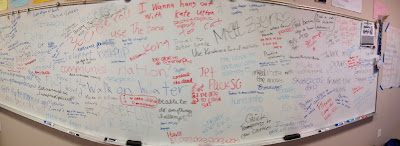I tried a version of Google’s 20% time last year. It didn’t go well for a lot of reasons. I was mixing 20% time (it was slated to be about 12% time, but the idea was there) with a self-paced class. Dead space that I built in between curricular units was supposed to be used for 20% time. Work from the units expanded and students didn’t have the time to work on their projects. And those projects - I didn’t do a great job of scaffolding them. There weren’t check-ins throughout the semester to talk about progress. There wasn’t a lot of choice in the product as the projects were research-based. I also graded the final products. So there you have it - I made pretty much all of the mistakes possible.
I spent a chunk of my summer researching 20% time. I did Google hangouts with a bunch of folks in my PLN to figure out a way to get the tension between self-paced work and 20% time to even out. When I went to the Google Apps for Education Summit this summer in the Bay Area, I intentionally checked out a couple workshops - by Kevin Brookhouser and Kate Petty - about 20% time.
I owned those failures to my students on the first day of school (I loop with my students, so the 9th graders I had last year are the same kids I have this year) and explained that we were getting rid of that project from last year. They were glad to hear it.
Today was the fruition of that promise: Day 1 of 20% time for the 2013-2014 year. I was a bit apprehensive about today - my students’ distaste for my failed 20% time last year worried me. However, my kids left class today jacked for the project. How did the day go down? By combining resources I ‘borrowed’ from Kate and Kevin.
I started class using the ninja Google script Doctopus on my kids to push out their individual brainstorming document to them. This doc was modified off of something I found on Kate’s great 20% time in education website. After about 15 minutes of brainstorming, I gave a brief description of the project. Like super brief: we’ll spend every Friday working on this, it will be based on your interests (and not history-related topics), and the final product wouldn’t be graded but there would be some small steps along the way that would be: a project proposal, a check-in speech at the semester break, and a final reflective TED-style talk about how you used your year of 20% time. Then, it was on to the Bad Idea Factory.
The Bad Idea Factory idea was also ‘borrowed,’ this time from Kevin. Students worked in groups to come up with ideas - some good, some bad, some really bad (phrasing stolen directly from Kevin’s excellent blog post about the Bad Idea Factory) - and recorded all ideas on binder paper. Yes, even the really bad ones. I passed out dry erase markers to kids and had them record ideas on the board. Varying levels of chaos ensued - you can see the results of the brainstorming of three of my four classes below. (Didn’t realize I should take a panoramic photo of the board until second period...)
But man, that energy though. In three of the four classes, it was just contagious. The volume went up, kids were hopping back and forth between their seats and the board. This feeling was especially present during my second period class - the 25 minutes we spent doing the Bad Idea Factory were 25 of the most fun minutes I’ve had in the classroom.
Next Friday I’m going to lay out the structure that my students 20% projects will exist in and they will do some more focused brainstorming. Perhaps some will even get to their project proposals. More next Friday on what day two of 20% time looked like!
 |
| Bad Idea Factory, period 2 |
 |
| Bad Idea Factory, period 3 |
 |
| Bad Idea Factory, period 5 |
No comments:
Post a Comment